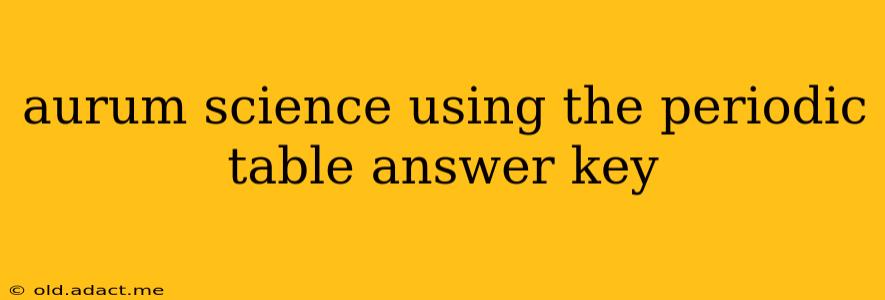Gold. The very word conjures images of wealth, royalty, and enduring beauty. But beyond its cultural significance, gold holds a fascinating place in the periodic table, offering a wealth of scientific understanding. This exploration delves into the properties and applications of aurum (the Latin name for gold, its symbol Au), using the periodic table as our guide. We'll unravel its mysteries, addressing common queries along the way.
What is the Atomic Number and Symbol of Gold?
Gold's atomic number is 79, meaning it possesses 79 protons in its nucleus. Its chemical symbol is Au, derived from its Latin name, aurum. This symbol, prominently displayed on the periodic table, immediately identifies this precious metal. Understanding the atomic number is crucial; it dictates the element's unique chemical properties and its position within the periodic table's structure.
What Period and Group is Gold In?
Gold resides in Period 6 and Group 11 of the periodic table. Its position in Period 6 indicates it has six electron shells, while its placement in Group 11 signifies it's a transition metal with one electron in its outermost shell. This arrangement contributes to its characteristic properties, including its malleability and conductivity. The group also highlights its relationship with other coinage metals like copper (Cu) and silver (Ag), sharing similarities in their physical and chemical attributes.
What are the Properties of Gold?
Gold is renowned for several distinctive properties, directly linked to its atomic structure:
- Malleability and Ductility: Gold is exceptionally malleable, meaning it can be hammered into thin sheets, and ductile, meaning it can be drawn into wires. This is due to the loosely held outermost electrons, allowing for easy atomic rearrangement.
- Conductivity: Gold is an excellent conductor of electricity and heat. This property stems from the ease with which electrons can move through its atomic structure. This makes it invaluable in electronics.
- Inertness: Gold's remarkable resistance to corrosion and oxidation is a key characteristic. It doesn't readily react with most chemicals, ensuring its longevity and suitability for various applications.
- Density: Gold is a dense metal, meaning it has a high mass for its volume. This contributes to its weight and makes it readily identifiable.
- Appearance: Gold's distinctive yellow color is another defining feature, a result of its interaction with light at the atomic level.
Why is Gold so Valuable?
Gold's value stems from a combination of factors:
- Rarity: Gold is a relatively rare element in the Earth's crust, making it precious.
- Durability: Its inertness ensures it doesn't corrode or tarnish easily, contributing to its lasting value.
- Conductivity: Its excellent conductivity makes it vital in electronics.
- Beauty: Its attractive yellow color and luster have made it a coveted material for jewelry and adornment for millennia.
- Industrial applications: Beyond jewelry, gold plays a crucial role in various industrial applications including electronics, dentistry, and medicine.
What are the Uses of Gold?
Gold's applications extend far beyond its use in jewelry:
- Electronics: Its high conductivity makes it essential in electronics for connectors, integrated circuits, and other components.
- Medicine: Gold compounds have applications in treating certain medical conditions like rheumatoid arthritis.
- Dentistry: Gold alloys are used in dental fillings and crowns due to their biocompatibility and durability.
- Investment: Gold is considered a safe haven asset and is often used as a hedge against inflation.
- Currency: Historically, gold has been used as currency and remains an important component of global financial reserves.
What are some interesting facts about Gold?
- A single gram of gold can be hammered into a sheet covering an area of approximately one square meter.
- Gold is highly resistant to acids, though it can be dissolved by aqua regia, a mixture of nitric and hydrochloric acids.
- Extremely small amounts of gold are present in seawater, though extracting it is economically impractical.
This exploration provides a foundational understanding of gold's properties and applications as seen through the lens of the periodic table. While the periodic table serves as an invaluable tool to understand the fundamental properties of all elements, it's the further study and application of these properties that unlock the extraordinary uses and enduring significance of aurum.
